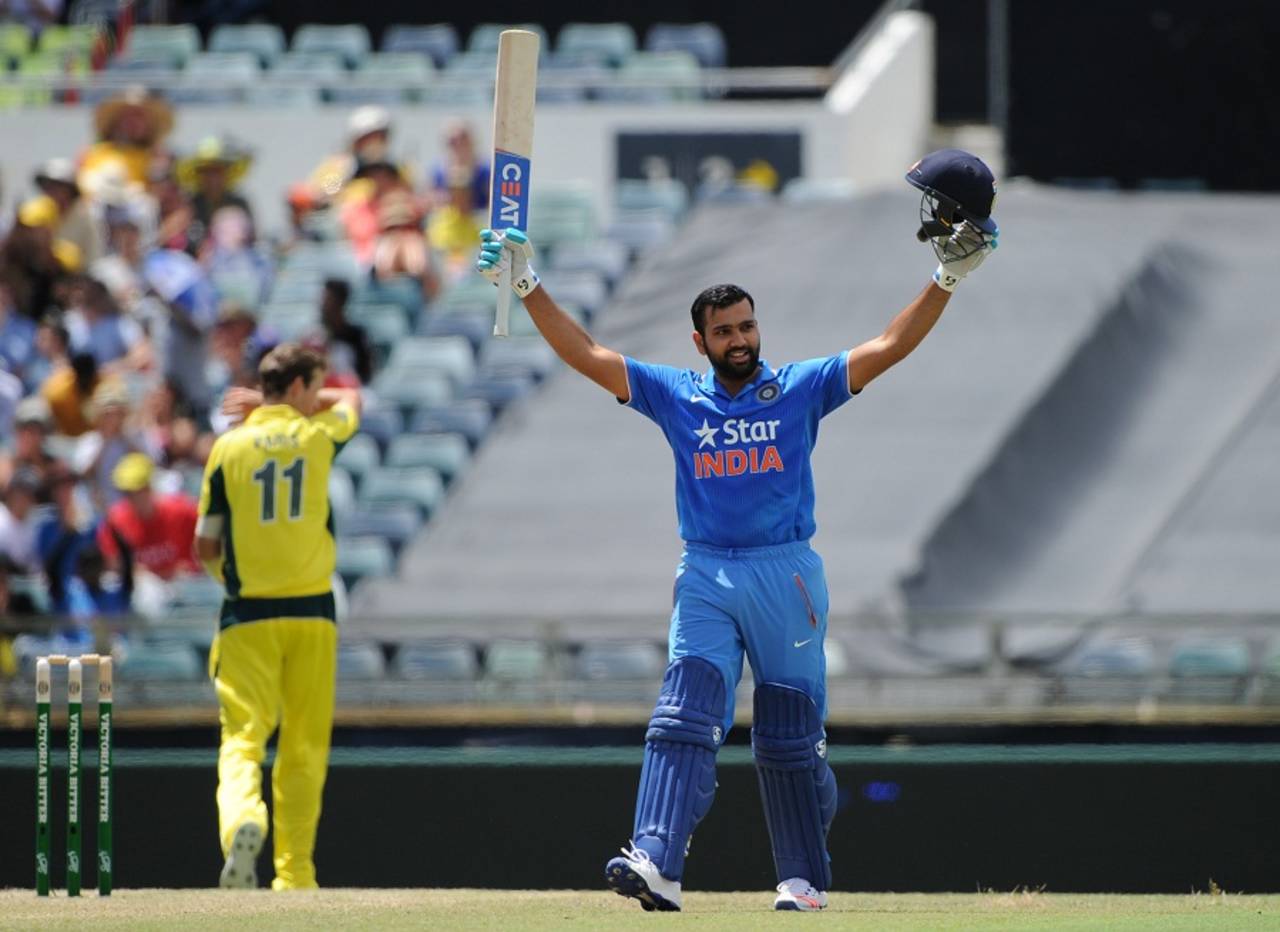The Rohit Sharma big-innings template
There is a certainty to his big ODI hundreds, a clear awareness of the match situation, and an innate skill that allows him to not panic when there are slow periods
Gaurav Joshi at the WACA
12-Jan-2016

Rohit Sharma's last five ODI hundreds: 171, 150, 137, 138 and 264. • AFP
Four out of Rohit Sharma's last five international hundreds have been part of heartbreaking scripts for India, but on an individual plane he might just be on his way to scripting the book on how an opener should bat ODIs. There is such a certainty to his big ODI hundreds, such situational awareness and that of the fields, that it leaves you totally confounded with his Test form. From the first ball he faced in Perth to the last, Rohit's unbeaten 171 was scored with hardly a shot hit in anger.
Even as the clutter of clapping got louder and Josh Hazlewood ran in for the first ball of a series hugely anticipated by the Aussie population of Indian descent, there seemed to be a certain calm to Rohit. He portrayed that by easing the first ball with a straight bat past mid-on for a couple. Early in the innings the focus was on decisive footwork, soft hands and a perpendicular bat. The principle was to be patient early and then cash in. It might sound simple enough but executing it to perfection is an art very few have mastered.
It was as if Rohit had the innings already mapped out in his mind. When Joel Paris attempted a bouncer, he rocked back and dispatched it under the electronic scoreboard 85 meters away. When Hazlewood pulled his length back to restrict his scoring opportunities, he waited for the right ball and then put it away with ease. It was a sign Rohit had enormous self-belief and those doubts that might creep into his mind in Test cricket were non-existent in the 50-over format. Lesser batsman panic and look for the big shot. Rohit trusted his game to capitalise when the loose ball would later arrive.
Almost without noticing he raced away to 36 from just 34 balls. It was like he had got through the traffic and then slipped into cruise control. For the next 29 balls, he hit only one four as he dabbed and glided the ball to reach his fifty. The first objective had been reached. It was time to revaluate the situation.
The next phase demanded the odd big shot with focus still on rotating strike. So Rohit did just that for the next 23 balls. He hit a couple of glorious, and well calculated, sixes against the weaker bowlers in Mitchell Marsh and Glenn Maxwell. The shots sent the crowd into raptures, and you could sense their expectation increasing.
Rohit was 23 away from a century, but focus had shifted to batting for far longer. As Smith brought back his most experienced pair in Hazlewood and Faulkner, he treated them with respect rather than contempt knowing his time would come. It was imperative for the sake of the team to bat through the innings.
Once again he turned into the accumulator as he went from 77 to 100 in 36 balls, with just one boundary. As he moved to 99, the crowd once again started the clatter of clapping, but just like he had been during the first ball of the day, Rohit remained calm to bring up his ninth ODI century, off 122 balls with seven fours and three sixes.
But Rohit doesn't only score hundreds; he scores big hundreds and it was time to entertain in a manner only Rohit can.
As he took guard once again, it seemed like the sound of ball hitting his bat got softer and softer and yet it travelled further and further. Some that looked like perfect yorkers were deposited over long-on. The short ones were just caressed on either side of the wicketkeeper depending on the field placing. In between the deft touches, he ensured good balls still leaked runs. Rohit was at his skilful best as he moved from 100 to 171 in just 41 balls.
MS Dhoni summed it up in the best manner: "Whenever a batsman plays a long innings, the most important thing there is how he carries on once he gets to 50, then how he carries on once he gets to 100. Most of the times, when Rohit crosses 100-110 he scores quite big and that's always good. He is one of the players in the team who can play all the shots, exploit the field well, and hits effortlessly"
It is no wonder Rohit's last five hundreds have been 171, 150, 137, 138 and 264. He has perfected a formula that works for him in the one-day arena. Since the Champions Trophy in June 2013, Rohit has seven hundreds and 14 fifties in 55 innings. He has gone past fifty in 21 out of these 55 innings, a formidable 38%.
Often the finishers such as Dhoni and Michael Bevan are credited for calculative minds to finish an innings but to sustain and constructing an innings across the duration of 50 overs is a skill just as important. It needs a calculation of its own. Rohit is setting a template for that.